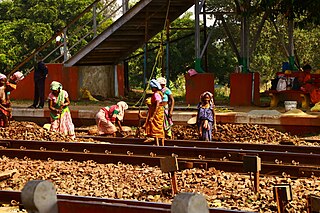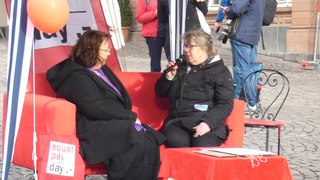
Labour economics, or labor economics, seeks to understand the functioning and dynamics of the markets for wage labour. Labour is a commodity that is supplied by labourers, usually in exchange for a wage paid by demanding firms. Because these labourers exist as parts of a social, institutional, or political system, labour economics must also account for social, cultural and political variables.
A minimum wage is the lowest remuneration that employers can legally pay their employees—the price floor below which employees may not sell their labor. Most countries had introduced minimum wage legislation by the end of the 20th century. Because minimum wages increase the cost of labor, companies often try to avoid minimum wage laws by using gig workers, by moving labor to locations with lower or nonexistent minimum wages, or by automating job functions. Minimum wage policies can vary significantly between countries or even within a country, with different regions, sectors, or age groups having their own minimum wage rates. These variations are often influenced by factors such as the cost of living, regional economic conditions, and industry-specific factors.
The iron law of wages is a proposed law of economics that asserts that real wages always tend, in the long run, toward the minimum wage necessary to sustain the life of the worker. The theory was first named by Ferdinand Lassalle in the mid-nineteenth century. Karl Marx and Friedrich Engels attribute the doctrine to Lassalle, the idea to Thomas Malthus's An Essay on the Principle of Population, and the terminology to Goethe's "great, eternal iron laws" in Das Göttliche.
Employment is a relationship between two parties regulating the provision of paid labour services. Usually based on a contract, one party, the employer, which might be a corporation, a not-for-profit organization, a co-operative, or any other entity, pays the other, the employee, in return for carrying out assigned work. Employees work in return for wages, which can be paid on the basis of an hourly rate, by piecework or an annual salary, depending on the type of work an employee does, the prevailing conditions of the sector and the bargaining power between the parties. Employees in some sectors may receive gratuities, bonus payments or stock options. In some types of employment, employees may receive benefits in addition to payment. Benefits may include health insurance, housing, disability insurance. Employment is typically governed by employment laws, organisation or legal contracts.

A wage is payment made by an employer to an employee for work done in a specific period of time. Some examples of wage payments include compensatory payments such as minimum wage, prevailing wage, and yearly bonuses, and remunerative payments such as prizes and tip payouts. Wages are part of the expenses that are involved in running a business. It is an obligation to the employee regardless of the profitability of the company.

A living wage is defined as the minimum income necessary for a worker to meet their basic needs. This is not the same as a subsistence wage, which refers to a biological minimum, or a solidarity wage, which refers to a minimum wage tracking labor productivity. Needs are defined to include food, housing, and other essential needs such as clothing. The goal of a living wage is to allow a worker to afford a basic but decent standard of living through employment without government subsidies. Due to the flexible nature of the term "needs", there is not one universally accepted measure of what a living wage is and as such it varies by location and household type. A related concept is that of a family wage – one sufficient to not only support oneself, but also to raise a family.

A salary is a form of periodic payment from an employer to an employee, which may be specified in an employment contract. It is contrasted with piece wages, where each job, hour or other unit is paid separately, rather than on a periodic basis. From the point of view of running a business, salary can also be viewed as the cost of acquiring and retaining human resources for running operations, and is then termed personnel expense or salary expense. In accounting, salaries are recorded in payroll accounts.

The working poor are working people whose incomes fall below a given poverty line due to low-income jobs and low familial household income. These are people who spend at least 27 weeks in a year working or looking for employment, but remain under the poverty threshold.
Labour power is the capacity to do work, a key concept used by Karl Marx in his critique of capitalist political economy. Marx distinguished between the capacity to do work, labour power, and the physical act of working, labour. Labour power exists in any kind of society, but on what terms it is traded or combined with means of production to produce goods and services has historically varied greatly.
Reserve army of labour is a concept in Karl Marx's critique of political economy. It refers to the unemployed and underemployed in capitalist society. It is synonymous with "industrial reserve army" or "relative surplus population", except that the unemployed can be defined as those actually looking for work and that the relative surplus population also includes people unable to work. The use of the word "army" refers to the workers being conscripted and regimented in the workplace in a hierarchy under the command or authority of the owners of capital.
Occupational segregation is the distribution of workers across and within occupations, based upon demographic characteristics, most often gender. Other types of occupational segregation include racial and ethnicity segregation, and sexual orientation segregation. These demographic characteristics often intersect. While a job refers to an actual position in a firm or industry, an occupation represents a group of similar jobs that require similar skill requirements and duties. Many occupations are segregated within themselves because of the differing jobs, but this is difficult to detect in terms of occupational data. Occupational segregation compares different groups and their occupations within the context of the entire labor force. The value or prestige of the jobs are typically not factored into the measurements.

The Soviet working class was, according to Marxist–Leninist theory, supposed to be the Soviet Union's ruling class during its transition from the socialist stage of development to full communism. However, according to Andy Blunden, its influence over production and policies diminished as the Soviet Union's existence progressed.
In Russia the wage gap exists and statistical analysis shows that most of it cannot be explained by lower qualifications of women compared to men. On the other hand, occupational segregation by gender and labor market discrimination seem to account for a large share of it.
Wage compression refers to the empirical regularity that wages for low-skilled workers and wages for high-skilled workers tend toward one another. As a result, the prevailing wage for a low-skilled worker exceeds the market-clearing wage, resulting in unemployment for low-skilled workers. Meanwhile, the prevailing wage for high-skilled workers is below the market-clearing wage, creating a short supply of high-skilled workers.
The Progressive Wage Model (PWM), also known as the progressive wage for short, is a wage structure in Singapore, advocated by the National Trades Union Congress (NTUC), the sole national trade union in Singapore. The objective of the Progressive Wage Model has been to increase the salaries of workers through the enhancement of skills and improving productivity.

The gender pay gap or gender wage gap is the average difference between the remuneration for men and women who are working. Women are generally found to be paid less than men. In the United States, for example, the average annual salary of a woman is 83% that of a man. However, this figure changes when controlled for confounding factors such as differences in hours worked, occupations chosen, education, job experience, and level of danger at work. Attempts to control for these factors arrive at adjusted figures from 95% to 99%.

In economics, the wage ratio refers to the ratio of the top salaries in a group to the bottom salaries. It is a measure of wage dispersion.
The proletariat is the social class of wage-earners, those members of a society whose only possession of significant economic value is their labour power. A member of such a class is a proletarian or a proletaire. Marxist philosophy regards the proletariat under conditions of capitalism as an exploited class - forced to accept meager wages in return for operating the means of production, which belong to the class of business owners, the bourgeoisie.
After the Chinese Communist Party (CCP) extended its ruling to most parts of China and set up a national government in Beijing in 1949, it encountered a lot of new tasks. The first was to rebuild the economy, which deteriorated sharply during the last years of Nationalist Party (KMT) governing. The strategy that led CCP to state power is termed as "using the rural areas to encircle the cities" (农村包围城市). Thus, one difficulty CCP had in economy was that it had little experience in dealing with the urban part of the economy. Furthermore, facing the threat of KMT's fighting back, it needed to consolidate its political power. To meet these challenges, a new and coherent wage system in the economic sector was needed. Naturally, this transformation of wage system had both political goals and economic goals. Economically, via setting up a new wage system, CCP wanted to stabilize the economic situation, to ensure normal people's everyday living and also to further develop the economy. Politically, CCP not only wanted to distinguish itself from the old KMT regime by this new wage system, but also to make the wage system suitable for the future socialist economy. After two wage reforms in 1952 and 1956, a new wage system was established, and its influence continued to today.

Wage growth is a rise of wage adjusted for inflations, often expressed in percentage. In macroeconomics, wage growth is one of the main indications to measure economic growth for a long-term since it reflects the consumer's purchasing power in the economy as well as the level of living standards. An increase in wage growth implies price inflation in the economy while a low wage growth indicates deflation that needs artificial interferences such as through fiscal policies by federal/state government. Minimum wage law is often introduced to increase wage growth by stimulating price inflations from corresponding purchasing powers in the economy. Wage growth can also be maximised through the development of industry factors by investing skilled workers in which decision made by businesses. More financial compensation for skilled workers not only lifts wage growth but stimulates higher market prices in the economy.







